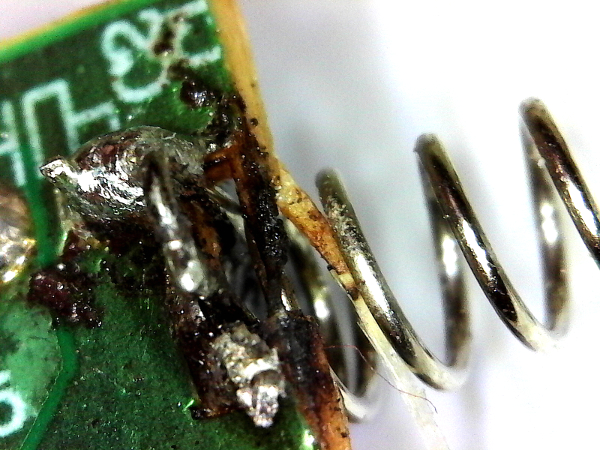10 Inexpensive Automotive USB Adapters Tested -- Are They Any Good?
Second Batch: Bigger Bullet Duo
Stepping up to a larger caliber, these two units tout an output rating of 2100 mA, sport a pair of stacked USB power outlets and look effectively identical from the outside aside from different text screen printed on their body. Both units are held together by press-fitted plastic stakes and glue or solvent welding. The unbranded freebie showed evidence of a significant glue or solvent spill on the inside, and it gave me a much harder time popping it open than the Fosmon unit. Since glue is the main structural component keeping these and the spring-loaded contact nub together, the tip of the first one I popped open caught me unaware and launched across the room. I will need to re-glue or tape them in some way if they turn out to be worth using.
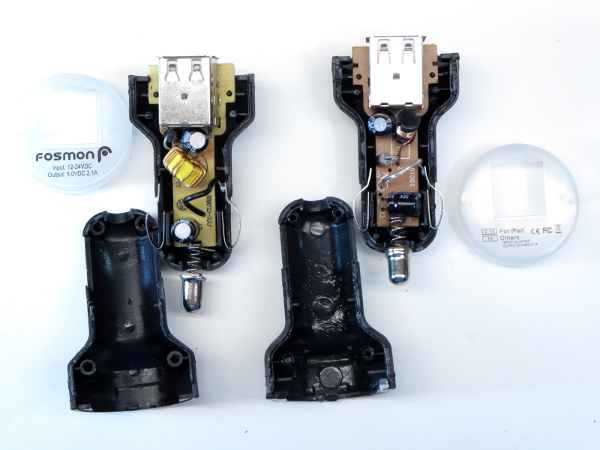
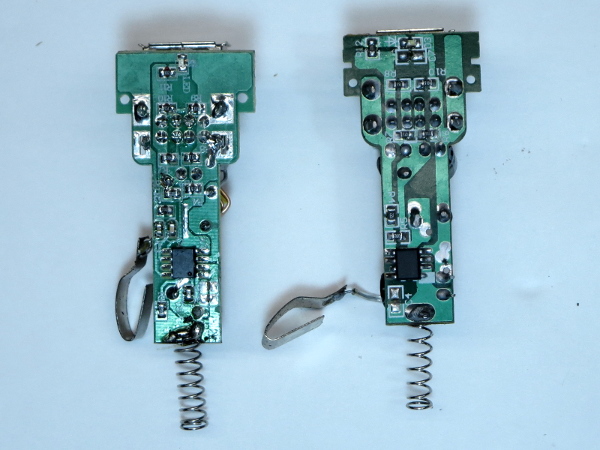
On the top side, slightly different component placement tells me these two aren’t exact clones. The generic unit has a bent-over input capacitor and a shoehorned-in spool core inductor slapped on what appears to be a much larger inductor footprint. The Fosmon unit’s toroidal inductor has fewer turns of what appears to be slightly thicker wiring, which should lend it a significant lead on efficiency. On the bottom side, it also has beefier copper fills connected to the regulator’s pads. Based on the previous results, I expect that to translate into better thermal performance. The Fosmon adapter has three ceramic capacitors where the nameless unit has none, leading me to expect lower noise from the Fosmon if those capacitors are across input and output supplies to ground. Both units also use a tiny (but bright) blue surface-mount LED powered from the 5 V output via a current-limiting resistor for power indication.
Someone had a hard time soldering the spring to the Fosmon unit’s PCB. First, its slot was too close to the board’s edge and the thin strip of PCB broke off. Then, without a copper pad on the other side of the hole to help hold the solder bead in place until it solidifies and locks the spring into place, the employee used tons of flux and increased soldering temperature to get the solder to hold onto the spring with what was left of the pad. This looks so bad that I could not find any angle that clearly did it justice.
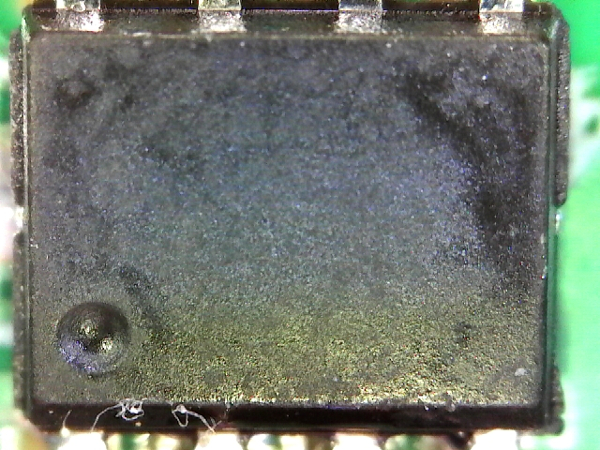
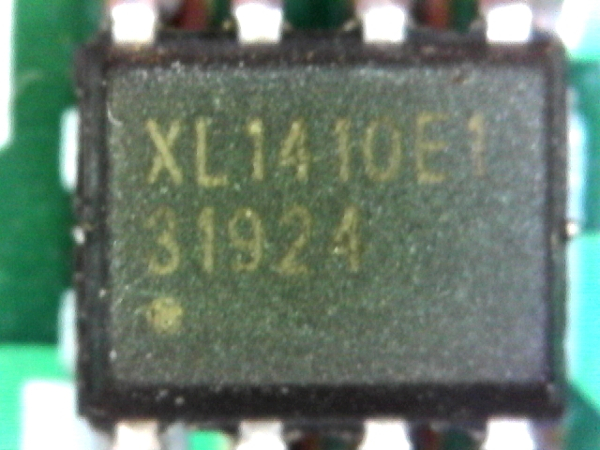
What chips do these units use? We’ll never know without reverse-engineering Fosman's circuit and cross-referencing the pin-out to find potential matches since its markings have been thoroughly removed. Given the lack of tooling marks, perhaps the chip was never marked in the first place, and the wet-looking spots are simply flux. For the other adapter, we have an XL1410E1 from XLSemi, one of those Chinese chip manufacturers that hosts its website on what seems like a dial-up connection. When I tried visiting the site simply to confirm the country of origin, it took five minutes to load the main page.
| Header Cell - Column 0 | Fosmon | unbranded |
|---|---|---|
| Adapter Rating | 2100 mA | 2100 mA |
| Regulator | Unknown | XLSemi XL1410E1 |
| Regulator Ratings | Unknown | 18 V, 2 A, 380 kHz, 90% eff. |
| Input capacitor | Jwco 25 V, 100 µF | szwx 35 V, 100 µF |
| Output capacitor | Chang 10,V 470 µF | Jackcon 10 V, 470 µF |
| Rectifier Diode | SR240(2 A, 40 V Schottky) | SR240(2 A, 40 V Schottky) |
| Input protection | None | None |
Based on component selection alone, neither unit is suitable for use in a 24 V system. The Fosmon adapter's input aluminum capacitor is only rated up to 25 V, while the nameless unit’s switching IC is only rated up to 20 V absolute maximum and 18 V operating input voltage. That's uncomfortably close to a 12 V vehicle’s normal system voltage, if you ask me. On the capacitor side, Fosmon uses known lower-tier capacitor brands, while the other one uses brands I do not remember ever seeing anywhere before, with “szwx” making me bat my eyebrows for a while. In case you were wondering, the company is called Shenzhen Wangxing and there isn’t much information about the company online aside from Chinese and other vendors claiming that it is the “best quality.” Shenzhen being what it is, take that with a grain of salt. Jackcon, on the other hand, is a Taiwanese brand well known from the motherboard capacitor plague years. Here, I believe the smart money would be on Fosmon and its mystery chip.
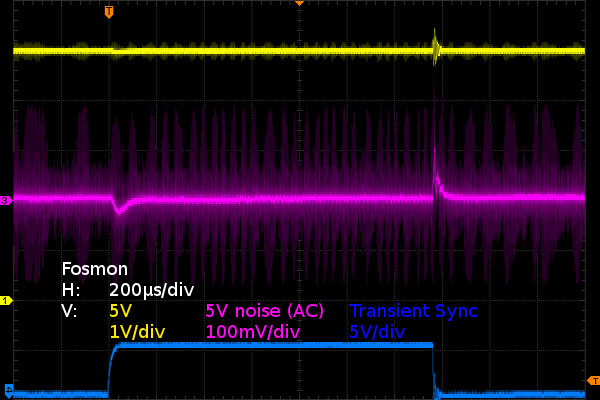
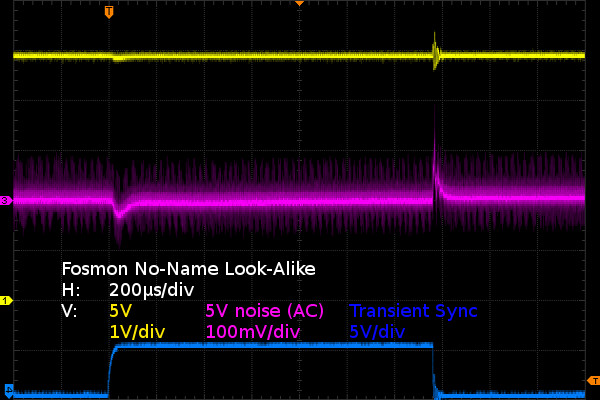
Where noise is concerned, this appears to be a clear win for the nameless unit. At a glance, it has roughly one-third as much peak-to-peak noise amplitude as the Fosmon adapter. As far as transients go, both adapters show negligible deviation from the baseline waveform, and regulation against line voltage looks spot-on in both cases. From the density of peaks on these waveforms, it looks like the Fosmon unit has somewhat of a flutter in its switching modulation, while the unbranded unit has more uniform noise output. Will Fosmon’s extra components pay off elsewhere or did I get mislead by thinking that its ceramic capacitors would give it an advantage? Time to check the numbers.
| Header Cell - Column 0 | Test Current | Fosmon | Fosmon Look-Alike |
|---|---|---|---|
| Output Voltage | 500 mA | 5.10 V | 5.04 V |
| 1000 mA | 5.08 V | 4.92 V | |
| 2100 mA | Fail (1.8 A @ 5.02 V)Thermal shutdown | Fail (1.2 A @ 4.88 V)Thermal shutdown | |
| Input Power | 500 mA | 2.964 W(247 mA @ 12.00 V) | 3.072 W(256 mA @ 12.00 V) |
| 1000 mA | 6.259 W(522 mA @ 11.99 V) | 6.469 W(540 mA @ 11.98 V) | |
| Max sustainable | 10.59 W(893 mA @ 11.86 V) | (628 mA @ 11.97 V) | |
| Efficiency | 500 mA | 86% | 82% |
| 1000 mA | 81% | 76% | |
| Max sustainable | 85% | 78% | |
| Noise (RMS) | 500 mA | 65 mV | 38 mV |
| 1000 mA | 97 mV | 50 mV | |
| Max sustainable | 120 mV @ 1.8 A | 52 mV @ 1.2 A | |
| Cold Current Limit | - | 3700 mA | 4600 mA |
| Hot Current Limit | - | 2800 mA | 2700 mA |
| 10-Second Short-Circuit | - | Pass(Thermal shutdown) | Pass(Thermal shutdown) |
Once again, neither adapter meet its claimed 2100 mA output current specification, with the no-name unit only managing about half of the output current before its thermal shutdown periodically kicks in. When cold, both units momentarily max out my dummy load’s 3.7 A maximum current. But after warming up, they only go up to 2.5 A even into a dead short. What does a “thermal shutdown” mean? It means that the chip has an internal sensor that turns off the internals and output when the chip exceeds a given temperature and turns everything back on after it cools down a little. The “small bullet” adapters also have thermal protection in the form of a temperature-dependent current limit, similar to how modern processors throttle clock rate to rein in power dissipation under excessive temperature conditions to prevent damage. Between its better thermals and more efficient toroidal inductor, Fosmon’s design does pull ahead on efficiency by as much as 7% at each units’ respective maximum sustainable output power.
Get Tom's Hardware's best news and in-depth reviews, straight to your inbox.
The figure I used as the maximum was determined by dialing down the current in 100 mA increments with each shutdown, starting from the maximum rated current until thermal shutdowns stopped occurring within three minutes from the latest step down. As with the previous trio, I suspect that Fosmon’s higher sustainable current delivery is partly thanks to its copper fill providing better heat dissipation and lower losses (mainly wiring) in its toroidal inductor, allowing its regulator to maintain a lower duty cycle. In both designs, there was a missed opportunity of using the 12 V socket’s ground contacts as heat sinks to significantly improve thermal performance.
On the noise side, the difference is not as large as it seemed on the waveforms. Why? While the Fosmon has about three times the peak-to-peak noise based on the waveforms, those peaks are very narrow. This reduces their contribution to the RMS value. While these adapters produce two to four times as much noise as the first trio, they also provide two to three times as much power at 20-25% higher efficiency. Despite their superior efficiency, these units do get warm while supplying this much extra power and the smell of toasty electronics asserts itself again.
Would you entrust your expensive mobile gadgetry to adapters that are barely built to survive normal voltages on a 12 V automotive electrical system? I guess not, so that’s two more for the fail bin. At least the Fosmon fails with some style by managing to keep efficiency above 80% across all three test points, and 1.8 A should be enough to power the majority of mobile gadgetry in a pinch.
Current page: Second Batch: Bigger Bullet Duo
Prev Page First Batch: The Bullet Trio Next Page Third Batch: Anodized Aluminum Club-
SpAwNtoHell Tho have the knoledge to test all of that myself i never bothered as my intuition always pointed that generic are beter next to nothing only. Genuine branded is what i always used for the all explained and revealed in your article; like samsung charger, htc charger and so on... and i always used 12 spliters... with the incovenience of the space...Reply -
Math Geek very interesting read. never thought it through this much but always assumed the $1 adapters were junk and generally bought name brand adapters for around $10 or so.Reply
but now i wonder and almost feel like taking one apart just to see what's inside. :) -
Daniel Sauvageau Reply18542197 said:No Anker in the review is a bummer, still, thanks for doing this!
At least one of Anker's Amazon listings has a 3D render showing the internals. At a glance, it seems quite similar to the LDNIO.18542229 said:but now i wonder and almost feel like taking one apart just to see what's inside. :)
If I do another one of these roundups, I'll try to get my hands on one. -
Math Geek i have a couple of the belkin and griffin brands in my cars. they are common adapters found at walmart for $10-15 depending on the model. seems like a decent trade off form the super cheap ones and the super expensive ones.Reply
but now you got the topic started, i wonder if they are worth the price and better than the junk ones i avoided. -
Daniel Sauvageau Well, throw adapter models/brands at me and I'll look around to see which ones I can grab for a reasonable price for Round 2.Reply -
Math Geek my next trip to walmart/target i'll make some notes. they carry roughly the same type stuff as best buy as far as brands go. will look for the midrange models i'd likely buy and post some for you :)Reply -
turkey3_scratch All of these have really high ripple. The ATX spec alone (and I know these don't have to follow that) defines 50mv max for the 5VSB rail. These all chill above 100mv.Reply
